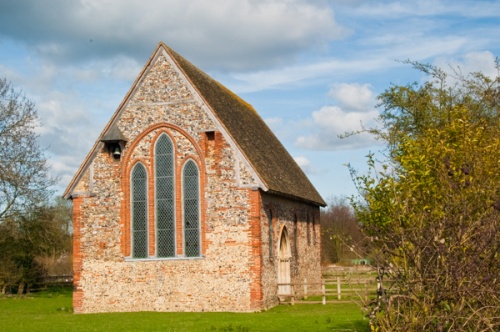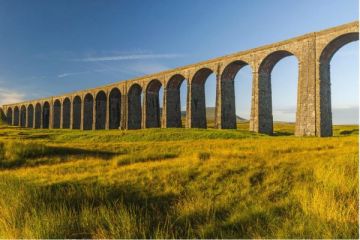
Coggeshall Abbey History
In 1140 King Stephen founded an abbey for monks of the Savigniac order at Coggeshall. The Savigniacs (sometimes called Sauvigniacs) were one of the smaller of the monastic orders in England; they were also short-lived, as the order collapsed in 1147 and was absorbed by the more powerful Cistercian order in 1148.
Like other Savigniac houses, Coggeshall became a Cistercian abbey. We know little about the early days of Coggeshall except that the abbey church was complete by 1167.
Though the abbey was established by a king, and received gifts and grants from several monarchs over the following centuries, it was never terribly large or prosperous. at its height their were 24 monks supported by 40 lay brothers. By the time of the Dissolution of the Monasteries the numbers had shrunk to just 6 monks, who were pensioned off by Henry VIII.
The earlier days of the abbey must have seemed more promising however; the crown granted rights to the abbot over the local town. Not surprisingly this led to tension between the townsfolk and the monks.
The abbey made matters worse by engaging in rather high-handed tactics; they enclosed their lands within a fence, diverted the course of the river, and built a small chapel to compete with the local parish church.
Things weren't all one-sided, however; the local vicar was convicted of fishing in the abbots pond. Matters reached a head in 1381 when the Peasant's Revolt broke out. Angry townsfolk broke into the abbey, assaulted the abbot, a destroyed the meticulous abbey archives.

The eventual fate of Coggeshall Abbey was sealed by Henry VIII in 1538 when the monastic house was dissolved. The abbey buildings were sold off and the site robbed for building stones. Sections of the claustral ranges survive at Abbey Farm, at the end of Abbey Lane. Two walls of the dorter stand, and foundations of the chapter house.
The abbots lodging survives, as does the guest house. These remains are open to view by arrangement with the owners, who welcome pre-booked tour groups and individual visitors through the Invitation to View scheme.
Visitors may view the Abbott's House, Cloisters and Guest House as well as parts of the 16th-century manor house attached to the Abbey. The combination has been called one of the finest medieval buildings in England.
The oldest parts of the monastic buildings are the abbot's house and guest house, dating to 1190. The cloisters are slightly later, around 1215. There is also a restored stew pond (where live fish were kept).
The real historical importance of Coggeshall Abbey comes from its extensive use of red brick. Though brick would later gain a reputation as a ubiquitous, rather low-class building material, it was hardly used at all after the Romans left in the 5th century, and when it was reintroduced in the early medieval period it was as a high-status, luxury building material.
The quality of the bricks at Coggeshall suggest that they were locally made rather than imported from the European continent.
A short stroll up the hill from the monastic buildings is St Nicholas Church on Abbey Lane. This delightful little church began as a small chapel beside the entrance to the abbey precinct. It dates to the early years of the 13th century.
The Cistercians often built a chapel beside the main abbey gates for the use of travellers, or for local residents who could not enter the abbey precinct. St Nicholas was probably not used for regular services, thus it has no font. It was constructed with hand-made local bricks, which - unlike today - were a high-status building material. The use of bricks at Coggeshall is one of the earliest recorded instances in the country.
After the Dissolution, the chapel building was used as a barn but was purchased by the parish church of St Peter ad Vincula in 1860. It was restored in 1896 and once again used for worship. It is a very simple Norman structure, of charming simplicity.

A far more famous remnant of the abbey presence is Grange Barn, now owned by the National Trust. The barn stands opposite the end of Abbey Lane, off the B1024 (Grange Hill). It was built in the mid-13th century and is one of the oldest surviving timber-framed buildings in Europe.
This enormous structure is 130 feet long and 45 feet wide, and when you stand inside and look up it is not hard to see why it is often called 'cathedral-like'.
Visiting Coggeshall Abbey
- You can easily see the exterior of Grange Barn at any time, but for official opening times see the National Trust website
- St Nicholas Church - again, you can view the exterior at any time. The church is open for worship one Sunday per month
- The Abbey Coggeshall (the monastic buildings) - open for pre-booked tours and for individuals through the Invitation to View scheme
About Coggeshall Abbey
Address: Abbey Lane,
Coggeshall,
Essex,
England, CO6 1RD
Attraction Type: Abbey
Location: On Abbey Lane, off Grange Hill (the B1024) on the southern edge of Coggeshall. The abbey is at the end of the lane.
Website: Coggeshall Abbey
Historic Houses Association
Location
map
OS: TL855222
Photo Credit: David Ross and Britain Express
NEARBY HISTORIC ATTRACTIONS
Heritage Rated from 1- 5 (low to exceptional) on historic interest
Coggeshall Grange Barn - 0.3 miles (Historic Building) ![]()
Coggeshall, St Peter ad Vincula Church - 0.4 miles (Historic Church) ![]()
Coggeshall Museum - 0.5 miles (Museum) ![]()
Paycockes - 0.5 miles (Historic Building) ![]()
Marks Hall Arboretum and Garden - 2.2 miles (Garden) ![]()
Cressing Temple Barns and Gardens - 4.1 miles (Historic Building) ![]()
Copford, St Michael and All Angels Church - 4.9 miles (Historic Church) ![]()
Layer Marney Tower - 5.3 miles (Historic Building) ![]()






